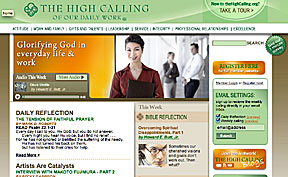Part 3 of series: Is Online Church Really Church?
Permalink for this post / Permalink for this series
Online church, sometimes called virtual church, is church mediated through the Internet, and it can contain a variety of modes.
 The basic element of online church involves live streaming of a worship service. For example, this summer I attended a conference at the United Methodist Church of the Resurrection in Leawood, Kansas (near Kansas City, Missouri). This amazing church, one of the newest and largest in its denomination, offers at least six different worship services on three different campuses. But you can also watch the worship service live over the Internet on Sundays at 10:45 a.m. and 5:00 p.m. CDT. If you miss the live service, you can watch a video of the sermon online. The Resurrection Live! webpage includes a variety of other Web-based resources. (Photo: The Church of the Resurrection)
The basic element of online church involves live streaming of a worship service. For example, this summer I attended a conference at the United Methodist Church of the Resurrection in Leawood, Kansas (near Kansas City, Missouri). This amazing church, one of the newest and largest in its denomination, offers at least six different worship services on three different campuses. But you can also watch the worship service live over the Internet on Sundays at 10:45 a.m. and 5:00 p.m. CDT. If you miss the live service, you can watch a video of the sermon online. The Resurrection Live! webpage includes a variety of other Web-based resources. (Photo: The Church of the Resurrection)
Online church could also involve teaching through the Internet. The most obvious modes would be blogging, posting teaching notes, podcasting of teaching, or even live streaming. Though I haven’t heard about a church doing this, one surely could use webinar technology to have a “live” teaching time with lots of online interaction (questions, discussion, etc.).
Of course online church would make use of ordinary Internet avenues, such as web pages and email. Moreover, by using online chatting with a webcam (or Skype), it would be possible for visual church to include Internet-mediated face-to-face, visual and auditory interaction.
With a little creativity, online church could serve many of the functions of in-the-flesh church. For example, suppose a member of an online church were sick. That person could communicate her need online. Another church member could use the Internet (or cheat, and use a cell phone) to have food or flowers delivered to her home.
Obviously, all of these online media could be used as an adjunct to traditional in-the-flesh church. Members who usually attend the church worship services could watch a service if they were sick or out of town. Social media sites could foster lots of personal communication, prayer requests, Bible study discussion, and the like. And, as I described earlier in this series concerning my ministry at Irvine Presbyterian Church, pastors could use a blog or e-blast newsletter to enlarge their teaching scope.
It is surely worth thinking carefully about the impact of online media on in-the-flesh churches. I expect I’ll offer a couple of thoughts about this as I write. But, in this series, I am mainly interested in the proposition that online church could supply a fully adequate church experience for a Christian. There are some who are proposing that a Christian could experience all that is necessary in church online. If that person chooses to attend an in-the-flesh church, that’s fine, but certainly not necessary.
Before I begin to address this proposition, I want to respond to those of my readers who think this whole conversation is just plain stupid. If you’re not convinced of the need for the church to find wise and theologically-solid ways to use the Internet, check out this YouTube video on the Social Media Revolution. I haven’t been able to verify all of the “facts” in this video, but they impress me as being more-or-less correct. No matter what you think of them, they demand our attention and creative response. (HT: my colleague, Perri Rosheger).

